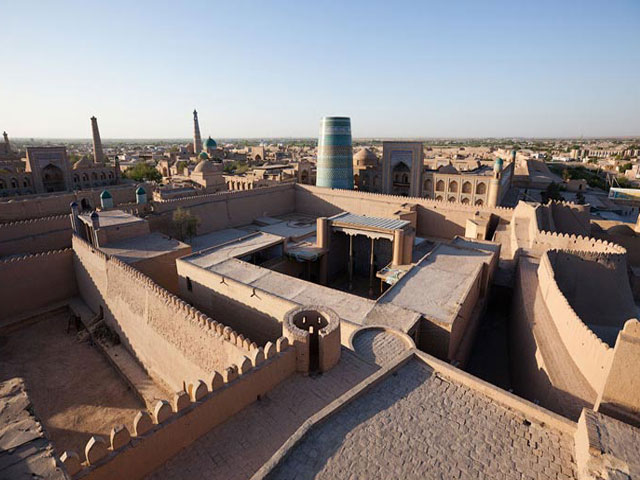Cities were traditionally split into two, isolated one from another as in Khiva: an internal town - Ichan-Kala (the shakhristan), and an external town - Dishan-Kala (the rabad).
The mysterious City of Khiva has managed to keep an exotic image of the eastern city in the ancient Ichan-Kala, where numerous architectural monuments are located.
The internal city occupies an area of about 30 hectares and has a rectangular form. Khiva was located in the limits of the Ichan-Kala fortress in the XVI and XVII centuries and is surrounded by a powerful clay wall with a height reaching 8-10 m, and in parts 6-8m thick and a length of more than 2200 m. The Ichan-Kala’s reinforced walls, with semicircular towers on its perimeter, provided a reliable protection of Khiva City. The darvaza (the gates) were located at the centre of each of the four parts of the Ichan-Kala wяlis. The western - Ata-Darvaza are located at the Kunya-Arch (the khan’s fortress), the northern - Bakhcha-Darvaza on the road to Urgench, the eastern - Palvan-Darvaza are postioned adjacent to the Khazarasp and the Amu Darya River, the southern - Tash-Darvazaon on the sand of the Kara-Kum.
The historical centre of Khiva, in particular the Ichan-Kala fortress, is entered in the list of the world heritage sites of UNESCO. There are a significant number of architectural monuments: khan palaces, mosques, madrasahs, mausoleums, minarets. The basic part of Khiva monuments were constructed in the XVIII and XIX centuries. At this time, there was an original architectural style in the Khoresm oasis, characterised by its majolica facings, wood, marble and alabaster plaster carvings. Because of this a number of Khiva’s buildings differ in their intricate ornamental styles covering their columns, arches, walls, arched ceilings and doors.
Of equal importance is the lay-out of Ichan-Kala which has kept the intricacy of its small streets and narrow dead-end alleys, typical of old eastern cities.























